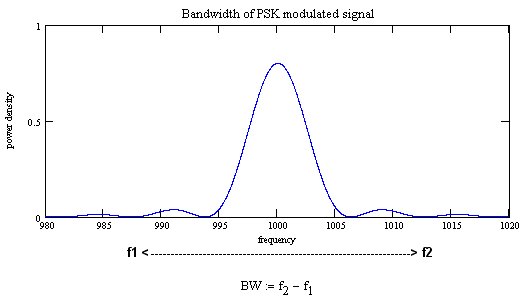Bandwidth: Difference between revisions
Jump to navigation
Jump to search
No edit summary |
(an example for "bandwidth") |
||
| Line 1: | Line 1: | ||
The [[Frequency]] range a signal occupies. |
The [[Frequency]] range a signal occupies. |
||
==An Example== |
|||
| ⚫ | |||
This picture shows the power density spectrum of an PSK modulated signal. You can see that around the center frequency of the signal an ''frequency interval'' from f1 to f2 is needed to transmit that signal.<br>As most of that signals in theory needs an unlimited bandwidth from -inf to +inf, the bandwidth covers the frequency interval |
|||
BW = f2 - f1 |
|||
which is needed to successfully transmit and recognize that signal. |
|||
[[Image:Bandwidth.jpg|Description]] |
|||
---- |
|||
| ⚫ | |||
| ⚫ | |||
| ⚫ | |||
[[Wikipedia:Bandwidth|Wikipedia's Bandwidth definition. Nice and comprehesive]] |
[[Wikipedia:Bandwidth|Wikipedia's Bandwidth definition. Nice and comprehesive]] |
||
Revision as of 19:11, 1 October 2004
The Frequency range a signal occupies.
An Example
This picture shows the power density spectrum of an PSK modulated signal. You can see that around the center frequency of the signal an frequency interval from f1 to f2 is needed to transmit that signal.
As most of that signals in theory needs an unlimited bandwidth from -inf to +inf, the bandwidth covers the frequency interval
BW = f2 - f1
which is needed to successfully transmit and recognize that signal.
any more picture here? Maybe several peaks in a spectrum diagram or the DVB-T/analog TV spectrum in a bigger european city, then the bandwidths used by different signals are nicely visualized. Or the simple 6/7/8MHz carrier picture for PAL or COFDM?
